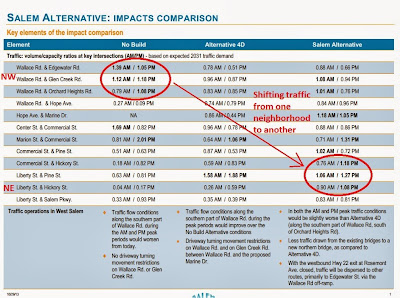Recently Cherriots has entered into negotiations with Jarrett Walker, the author of
Human Transit,
the book and
the blog, for a "comprehensive system analysis."
This is perhaps slender for a full post; you'll see there's a good bit of missing information. On the other hand, it is an interesting development.
The Request for Proposals closed last month and Cherriots
received four qualified proposals. Last month the Board gave approval to negotiate with the high scorer.
And it turns out the winner is Jarrett Walker and his firm
Jarrett Walker + Associates.
The RFP itself is unfortunately locked behind a byzantine database wall, the "
Oregon Procurement Information Network
(ORPIN)." Ostensibly constructed to ensure fairness for bidders, it
doesn't work very well for the interested public and seems on the
contrary to erect as many barriers as possible between the public and
public documents! And since the contract is not yet signed, Cherriots is not able to say much beyond the public documents - which themselves are effectively out of reach. (Not very transparent, alas.)
So we'll go with
a summary of the Request for Proposals (we're just googling here, and it's at least possible, though not probably very likely, this is bad data, so a little
caveat emptor):
The CSA [comprehensive system analysis] will study the impacts of
roadway, land use, and demographic changes occurring in the District service areas over
the next 10 years that will affect public transit service, and make recommendations for
improvement in service in each year.
An evaluation of System operations, equipment, and
facility requirements for short-range (1-3 years) and long-range (4-10 years) will be
completed. The core of the CSA is a short-range plan that will recommend mode and program
changes designed to improve service efficiency, apply resources where they are most
needed, and modernize the transit system based upon current and projected conditions
within the service area. The CSA should also provide short- and long-range direction in
terms of service expansion, equipment requirements, and future facility needs. [italics added]
Presumably once a contract is signed, more information will be released.
The CSA (yeah - you probably think a box of yummy veggies, too, right?) calls out "roadway, land use, and demographic changes" and it will be interesting to learn more about how these factor into the study. Even as we talk about making Salem more bikeable and walkable, we keep plopping new development on the outer edges where it is most difficult to walk and bike and use transit. We don't integrate land-use and transportation planning very well. In the aughts,
the City and DLCD argued over this very matter, and the City dug in so deeply that the DLCD gave up. This will be another opportunity to discuss some of the matters and maybe execute some course-correction.
 |
Salem's greatest density is on east side around anti-walkable Lancaster
Not anywhere close to downtown, transit center!
Income and ethnicity is obviously a big factor here also
The dark census blocks = a little over 10,000 people/square mile
map from The Atlantic |
This study also comes at an interesting time. Cherriots has really stayed in the background in the debate on the Third Bridge. It would be a plausible scenario for a transit agency to offer a vigorous defense of transit's power to reduce congestion. Instead, our agency has been pretty meek, maybe even a doormat, on the Bridge. Maybe an outside consultant will be able to galvanize the agency. With the seismic work at the Capitol and a cascade of land use changes, including changes to parking on the mall, Cherriots will also have an opportunity to attract new transit users among State workers. The Keizer Transit Station
doesn't work very well as a multi-modal hub, and there will be an opportunity to do a better job with the planned South Transit Station.
Without the RFP, it's hard to know the right level of generality. Maybe these things are too strategic, too high-level, and that the study will focus more on fiddling with - or optimizing, if you prefer - schedules, routes, and whatnot. It's crazy, for example, that the bus schedule doesn't work for Salem Hospital! And there's still the question of weekend and evening service.
Like with all studies, it's a blank slate and collectively we can do much or do little with them.
(For more on Walker...He's been in-and-out of Portland a lot lately, and recently you might have seen that he gave
an interview to Willamette Week. Here is a link to
his recent Center for Transportation Studies talk. And a group of videos from "
A Field Guide to Transportation Quarrels.")
Update
 |
Transit Oriented Development envisioned in
Salem Futures, 2002
(click to enlarge) |

















































